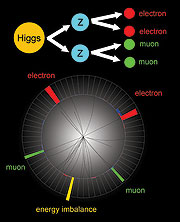Subatomic CSI
 |
|
This DZero event is not thought to have come from a Higgs boson, but an event in which a Higgs boson decayed into a pair of Z bosons would look very similar.
|
When scientists describe a particular measurement, it is rarely what we actually observed. For instance, observing the Higgs boson will not involve actually seeing the Higgs boson itself, but rather the Higgs boson's stable particles that actually interact with the detector.
There are many particles that exist for too short a period of time to view them directly, but we'll focus on the Higgs for this column. We've not observed the Higgs boson, but if Higgs theory is correct, the Higgs boson has a lifetime of about 10-22 seconds if it exists in the mass range we suspect. This means that even if it is moving at nearly the speed of light, the Higgs boson will travel a distance only a few times the size of a proton before it decays. That's too quick for us to observe, so we have to look at the final results. For simplicity, let's say the Higgs boson decays into two Z bosons, even though that's rare in that mass range.
The Z bosons are themselves unstable and exist for an even shorter amount of time (3 x 10-25 seconds). Say one Z boson decays into an electron-positron pair, while the other Z boson decays into a matter-antimatter pair of muons. Electrons and muons are relatively stable, so those are what we would observe in the detector.
If we only see the electrons and muons, how do we know what started the decay chain? Referred to as the parent, the original particle decays into daughter particles, their decay products are granddaughter particles and so on. To determine the original ancestor, we exploit basic energy and momentum conservation laws. The parent and daughter particles have exactly the same energy and momentum, since energy and momentum are conserved. For instance, if we take the two muon granddaughter particles and precisely measure their energy and momentum, we can combine them and determine the energy and momentum of their parent, one of the Z particles. We can do the same for the other Z particle, and finally we can combine the energy and momentum of the two daughter Z bosons to determine the energy and momentum of the parent particle that might be a Higgs boson.
With the measurement of the energy and momentum of the possible Higgs boson, we can use Einstein's equations to determine its mass. We repeat this procedure for all events with this particular characteristic (two electrons and two muons) and then create a graph that shows how many Higgs boson candidates we have for each measured mass. We then compare the predictions of a theory without the Higgs boson to our measurement. If we find too many unexpected particles at a particular mass, then possibly we are seeing the Higgs. And while we're only looking at one specific manner of Higgs boson decay here, we use the same approach for all decay modes and then combine the measurements.
Although we only described the Higgs boson here, the approach is universally applicable. For many of our physics analyses, we observe the decay products and have to work back to determine the properties of the parent. We use the first principles we encounter in introductory physics to investigate some of the deepest mysteries of the universe.
Want a phrase defined? Have a question? Email Fermilab Today.
—Don Lincoln
|